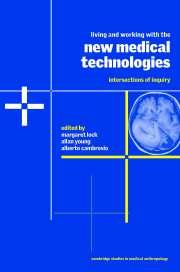Book contents
- Frontmatter
- Contents
- List of contributors
- 1 Introduction
- Part I Epochal transitions? Biomedicine and the transformation of socionature
- Part II Laboratories and clinics: the material cultures of biomedicine
- 4 Trustworthy knowledge and desperate patients: clinical tests for new drugs from cancer to AIDS
- 5 Pathology and the clinic: an ethnographic presentation of two atheroscleroses
- 6 “Real compared to what?”: Diagnosing leukemias and lymphomas
- 7 History, hystery and psychiatric styles of reasoning
- Part III Technologies and bodies: the extended networks of biomedicine
- Index
6 - “Real compared to what?”: Diagnosing leukemias and lymphomas
Published online by Cambridge University Press: 23 December 2009
- Frontmatter
- Contents
- List of contributors
- 1 Introduction
- Part I Epochal transitions? Biomedicine and the transformation of socionature
- Part II Laboratories and clinics: the material cultures of biomedicine
- 4 Trustworthy knowledge and desperate patients: clinical tests for new drugs from cancer to AIDS
- 5 Pathology and the clinic: an ethnographic presentation of two atheroscleroses
- 6 “Real compared to what?”: Diagnosing leukemias and lymphomas
- 7 History, hystery and psychiatric styles of reasoning
- Part III Technologies and bodies: the extended networks of biomedicine
- Index
Summary
Reviewing the classification of lymphomas in the late 1970s, Henry et al. concluded rather gloomily:
Ten years ago Willis (1967) wrote: “Nowhere in pathology has a chaos of names so clouded clear concepts as in the subject of lymphoid tumors.”
We now have a reasonably satisfactory working classification and approach to the diagnosis of Hodgkins disease, but as far as non-Hodgkins lymphomas are concerned there is currently no universally accepted classification.
(Henry et al. 1978: 275)Sixteen years later, having found the original reference for the Willis quote (Willis 1948), Rosenberg figured it was a case of plus ça change: “It was Willis who in his 1948 textbook stated, ‘Nowhere in pathology has a chaos of names so clouded clear concepts as in the subject of lymphoid tumours.’ The situation has not changed today” (Rosenberg 1994: 1359).
Taken separately, each quotation laments the lack of consensus in the classification of lymphomas. Taken together, they seem further to imply that the field itself is advancing at a snail's pace. This, despite the availability of radically new diagnostic tools, borrowed from immunology, cytogenetics and molecular biology. And yet, Rosenberg's somewhat jaded remarks appeared in an editorial criticizing a 1994 proposal for a new classification of lymphomas that incorporated (in addition to traditional morphological and clinical criteria) the latest antibody and cytogenetic techniques and that claimed, as a result, to have finally pinpointed well-defined, real disease entities (Harris et al. 1994: 1361).
- Type
- Chapter
- Information
- Living and Working with the New Medical TechnologiesIntersections of Inquiry, pp. 103 - 134Publisher: Cambridge University PressPrint publication year: 2000
- 7
- Cited by



